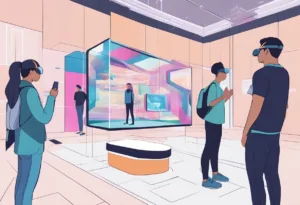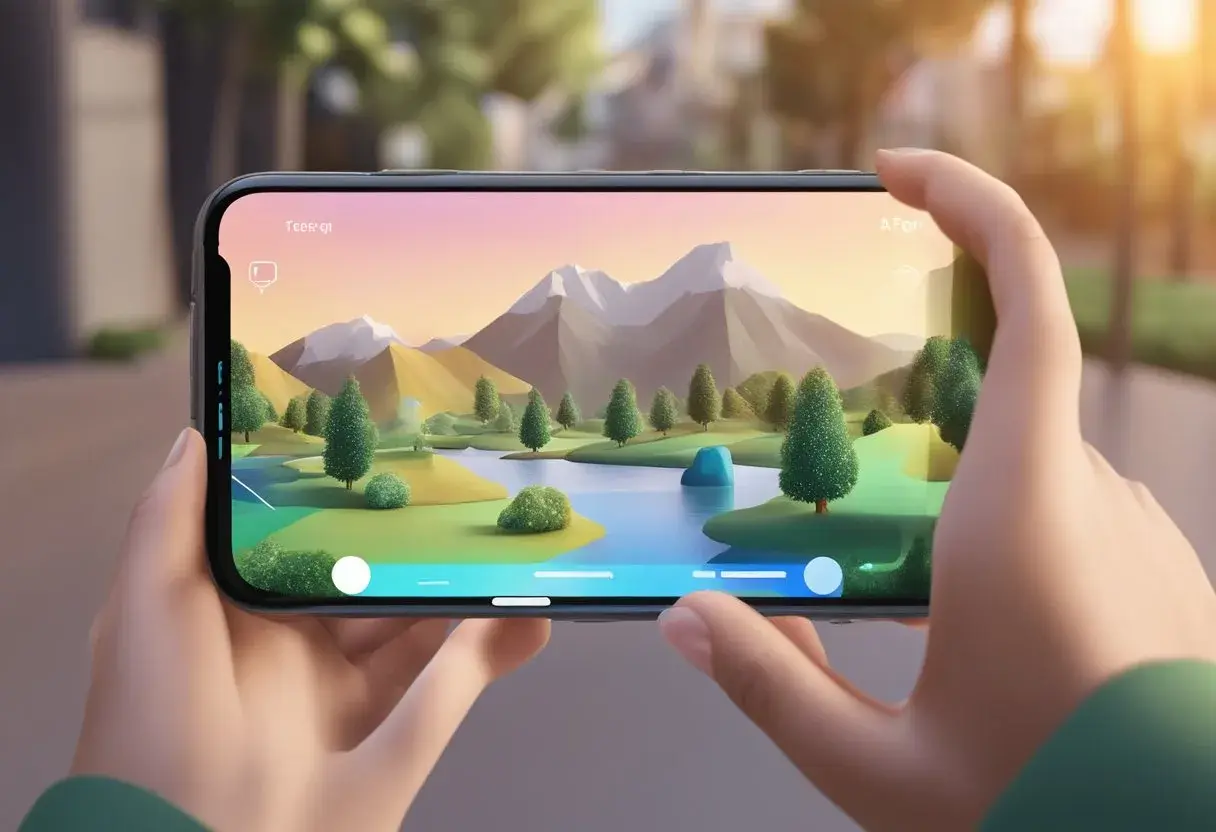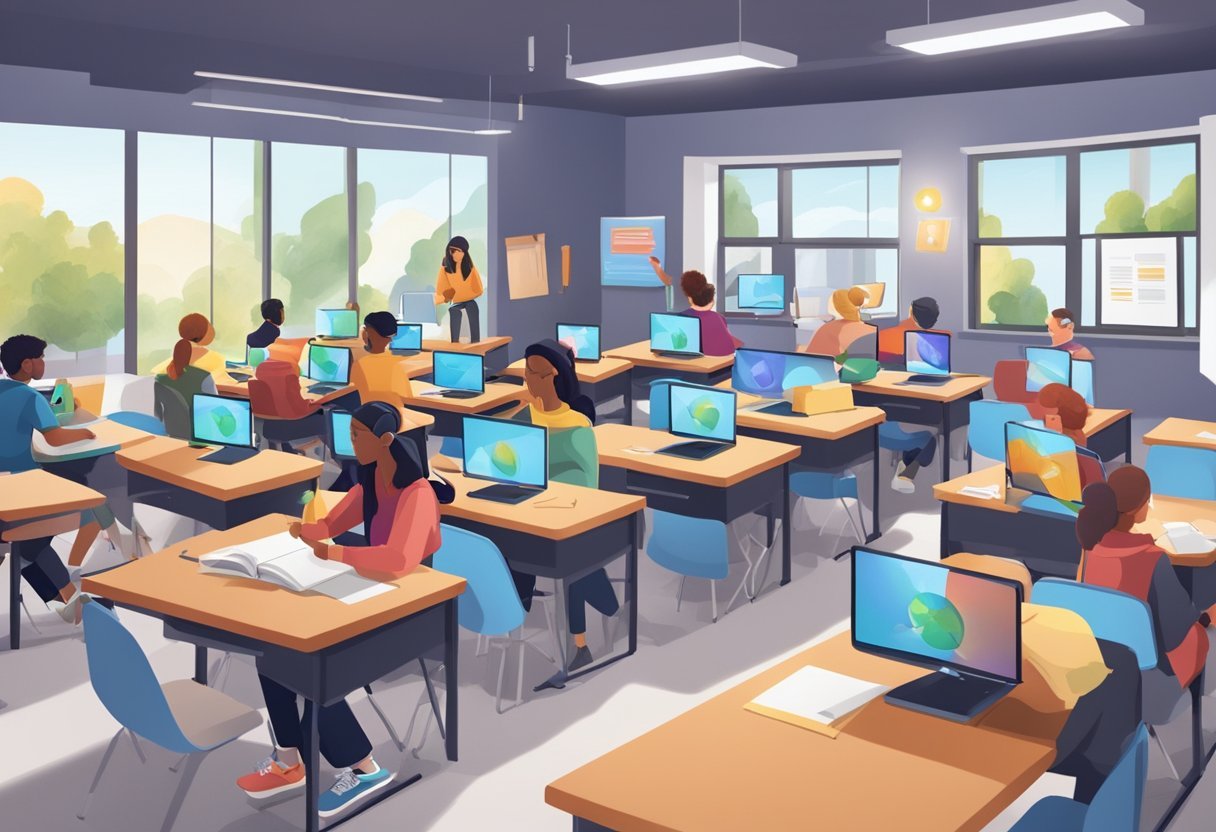Augmented reality exhibitions are becoming increasingly popular in museums and galleries around the world. With the help of advanced technologies, visitors can now experience exhibits in a whole new way. Augmented reality allows visitors to interact with the exhibits, bringing them to life and giving them a deeper understanding of the subject matter. In this blog post, you will learn about augmented reality exhibitions and how augmented reality is used in exhibitions to provide immersive user experience
One of the key benefits of augmented reality exhibitions is that they can be tailored to suit different audiences. For example, children can enjoy a more interactive experience, while adults can delve deeper into the subject matter. Augmented reality exhibitions can also be used to enhance accessibility for people with disabilities, such as those with visual impairments.
What are augmented reality exhibitions
Augmented reality exhibitions are interactive museum exhibits that use technology to superimpose images, text, or sounds on top of what a person can already see. This technology enhances the visitor experience by providing an immersive and engaging experience. Unlike traditional exhibitions, augmented reality exhibitions allow visitors to interact with exhibits in a more personalized way.
Role of augmented reality exhibitions
Augmented reality exhibitions play a crucial role in the evolution of museums. They provide a unique and exciting way for visitors to learn about history, science, and art. These exhibitions have become more popular in recent years, especially during the pandemic, as they allow visitors to experience museums from the comfort of their homes. Augmented reality exhibitions also provide museums with the opportunity to showcase their collections in new and innovative ways, attracting a wider audience.
How augmented reality exhibitions work
Augmented reality exhibitions work by using a smartphone or tablet to alter the existing picture via an app. The user stands in front of a scene and holds up their device. The app will show them an altered version of reality, allowing them to interact with the exhibit in a more personalized way. Augmented reality exhibitions can also include animations, videos, and other interactive elements, making the experience more engaging.
Augmented reality exhibitions have revolutionized the way museums interact with visitors. They provide an immersive and engaging experience that allows visitors to interact with exhibits in a more personalized way. Augmented reality exhibitions have become an essential part of the museum experience, providing a unique and exciting way for visitors to learn about history, science, and art.
How AR can be used in exhibitions
Augmented Reality (AR) has the potential to revolutionize the way visitors experience exhibitions. Here are five ways in which AR can be used in exhibitions:
1. Enhance exhibits with digital overlays
AR can be used to superimpose digital overlays on exhibits, providing visitors with additional information, interactive elements, and immersive experiences. For example, visitors could use an AR app to scan a painting, and see animations that explain the story behind it.
2. Create virtual exhibits
AR can be used to create virtual exhibits that can be accessed from anywhere in the world. This allows museums to reach a wider audience and provide a more engaging experience for visitors who cannot physically attend the exhibition.
3. Augment museum guides
AR can be used to augment museum guides, providing visitors with a more interactive and personalized experience. For example, visitors could use an AR app to scan a QR code next to an exhibit, and receive a personalized audio guide that provides additional information and context.
4. Gamify the exhibition experience
AR can be used to gamify the exhibition experience, providing visitors with challenges and rewards that encourage exploration and engagement. For example, visitors could use an AR app to scan a series of exhibits, and receive a prize at the end.
5. Provide accessibility features
AR can be used to provide accessibility features for visitors with disabilities. For example, visitors with visual impairments could use an AR app to scan exhibits, and receive audio descriptions of what they are looking at.
By using AR in exhibitions, museums can provide visitors with a more engaging and interactive experience, while also reaching a wider audience. AR has the potential to revolutionize the way we experience art and history, and it is exciting to see how it will be used in the future.
How to create an Augmented Reality exhibition
Step 1: Define Your Concept
Start by defining the concept of your augmented reality (AR) exhibition. Determine what story you want to tell or what experience you want to create for your visitors. This concept will guide all subsequent decisions.
Step 2: Identify Your Audience
Understand who your target audience is and what their interests and technological savviness are. This will help tailor the AR experience to their preferences and ensure it’s accessible and engaging.
Step 3: Select the Content
Choose which artifacts, artworks, or exhibits you want to enhance with AR. The content should be suitable for augmentation and benefit from the additional layer of digital information.
Step 4: Create the Digital Assets
Develop the digital assets that will be overlaid onto the physical exhibits. This could include 3D models, animations, videos, audio narrations, or interactive elements. Ensure these assets are high quality and relevant to the content.
Step 5: Choose the AR Platform
Decide on the AR platform or technology you will use, such as AR glasses, mobile devices, or projection mapping. The choice will depend on your concept, content, and audience.
Step 6: Develop the AR Application
Work with developers to create the AR application that visitors will use to access the digital content. The app should be user-friendly, intuitive, and provide a seamless AR experience.
Step 7: Integrate with Physical Space
Design the layout of the physical exhibition space to complement the AR experience. Consider the placement of markers or triggers that will activate the AR content, and ensure there is adequate space for visitors to move and interact with the exhibits.
Step 8: Test the Experience
Conduct thorough testing of the AR experience within the exhibition space to ensure everything works as intended. Test with a variety of users to gather feedback and make necessary adjustments.
Step 9: Train Your Staff
Educate your staff on how the AR exhibition works and how to assist visitors in using the AR technology. They should be able to troubleshoot any issues and enhance the visitor experience with additional information.
Step 10: Market the Exhibition
Develop a marketing campaign to promote your AR exhibition. Highlight the unique AR elements and how they enhance the visitor experience. Use social media, traditional media, and community outreach to attract visitors.
Step 11: Launch the Exhibition
Open your exhibition to the public. Monitor the performance of the AR elements closely during the initial days to address any technical issues promptly.
Step 12: Collect Visitor Feedback
Gather feedback from visitors about their AR experience. Use surveys, interviews, and observation to understand what is working well and what can be improved.
Step 13: Analyze and Iterate
Analyze the feedback and data collected to assess the success of the AR exhibition. Make iterative improvements to the content and technology based on visitor responses and technological advancements.
Step 14: Maintain the Technology
Regularly update and maintain the AR technology and application to ensure they remain functional and engaging. Keep the digital content fresh to encourage repeat visits and sustained interest.
Benefits of Augmented Reality Exhibitions
Augmented Reality (AR) exhibitions are gaining popularity in the museum and trade show industry. Here are five benefits of incorporating AR into your exhibitions:
1. Enhanced Engagement
AR exhibitions offer a unique experience that combines the real world with virtual elements. This creates an interactive and immersive experience for visitors, resulting in increased engagement and interest in your exhibition. AR technology allows visitors to interact with exhibits in new and exciting ways, making the experience more memorable.
2. Improved Learning
AR technology can provide visitors with additional information about exhibits, increasing their understanding and knowledge of the subject matter. This can be achieved through the use of AR overlays, which can display additional information such as videos, images, and text. Visitors can learn at their own pace and in a more interactive way, resulting in a more enjoyable and effective learning experience.
3. Increased Accessibility
AR exhibitions can provide accessibility features that cater to visitors with disabilities. For example, AR technology can provide audio descriptions of exhibits, making the exhibition more accessible to visually impaired visitors. AR can also provide translations of exhibit information, making the exhibition more accessible to non-native speakers.
4. Cost-Effective
AR technology can be a cost-effective solution for exhibitions. Unlike traditional exhibits, which require physical objects and materials, AR exhibits can be created using digital assets. This reduces the cost of creating and maintaining exhibits, making it a more affordable option for museums and trade shows.
5. Flexibility
AR technology allows for flexibility in exhibition design. Exhibits can be easily updated and changed without the need for physical modifications. This allows museums and trade shows to keep their exhibitions fresh and up-to-date, resulting in increased visitor interest and attendance.
Incorporating AR technology into exhibitions can provide many benefits, including enhanced engagement, improved learning, increased accessibility, cost-effectiveness, and flexibility. By providing a unique and interactive experience, AR exhibitions can attract a wider audience and create a more memorable experience for visitors.
Limitations of Augmented Reality Exhibitions

While augmented reality (AR) exhibitions have great potential to enhance the visitor experience, they also come with several limitations that need to be considered. Here are five limitations of AR exhibitions:
1. Limited Device Compatibility
AR technology requires specific hardware and software to function. This means that not all devices are compatible with AR exhibitions, and visitors may need to download a specific app or use a specific device to access the AR content. This can limit the number of visitors who can participate in the AR experience.
2. Limited Field of View
AR experiences are limited by the field of view of the device being used. This means that visitors may need to move their devices around to see all of the AR content, which can be distracting and take away from the overall experience. The size of the device’s screen can limit the amount of AR content that can be displayed at once.
3. Technical Issues
AR technology is still relatively new and can be prone to technical issues such as glitches and errors. This can be frustrating for visitors who are trying to access the AR content and can take away from the overall experience.
4. Cost
Implementing AR technology in exhibitions can be costly, as it requires specialized hardware and software. This can limit the number of museums and galleries that are able to offer AR experiences to their visitors.
5. Limited Accessibility
AR exhibitions may not be accessible to all visitors, particularly those with disabilities. For example, visitors with visual impairments may not be able to fully participate in AR experiences that rely heavily on visual content.
Technological Foundations of AR Exhibitions
Understanding AR, VR, and Mixed Reality
Augmented Reality (AR) is a technology that overlays digital information on the real world. It is different from Virtual Reality (VR), which creates a completely immersive digital environment, and Mixed Reality (MR), which combines the real and digital worlds. AR is becoming increasingly popular in museums and exhibitions, as it allows visitors to interact with exhibits in new and exciting ways.
Hardware and Software Requirements
In order to experience AR, you need a device that can display digital information on top of the real world. Smartphones and tablets are the most common devices used for AR, as they have built-in cameras and displays. However, specialized AR hardware such as Microsoft’s HoloLens and Magic Leap’s One are also available.
To create AR experiences, developers use specialized software development kits (SDKs) such as Apple’s ARKit and Google’s ARCore. These SDKs provide tools for creating 3D models, tracking the user’s position and orientation, and rendering digital content on top of the real world. AR experiences can also be created using AR apps, which are available on app stores for both iOS and Android devices.
AR exhibitions require a combination of hardware and software to create engaging and interactive experiences for visitors. By understanding the technological foundations of AR, museums and exhibition organizers can create innovative and exciting exhibits that capture the imagination of their visitors.
Design and Development of AR Experiences
Creating engaging AR content for museums requires collaboration between artists and technologists. The design process must consider the unique needs of the museum and its visitors. The development process must ensure that the AR experience is seamless and easy to use.
Creating Engaging AR Content for Museums
Designing AR experiences for museums requires a deep understanding of the museum’s collection and its audience. The AR experience should enhance the visitor’s experience and provide a new perspective on the artifacts.
To create engaging AR content, the artists and curators must work together to identify the most relevant artifacts. The AR experience should provide additional information about the artifacts that is not available through traditional exhibits.
The AR experience should also be interactive and allow visitors to engage with the artifacts in new ways. This can be achieved through games, quizzes, or other interactive elements.
Collaboration Between Artists and Technologists
The collaboration between artists and technologists is critical to the success of the AR experience. The artists bring their creative vision to the project, while the technologists bring their technical expertise.
The artists and technologists must work closely together to ensure that the AR experience is seamless and easy to use. The AR experience must be designed to work on a variety of devices and platforms.
The development process must also consider the museum’s infrastructure and resources. The AR experience should be designed to work within the museum’s existing technology infrastructure.
Augmented Reality Exhibitions: Use Cases
Augmented reality (AR) technology has opened up new possibilities for museums and art galleries to enhance their exhibitions and provide a more interactive and engaging experience for visitors. Here are five use cases for augmented reality exhibitions:
1. Bringing Artworks to Life
AR technology can be used to bring static artworks to life, allowing visitors to see them in a new and interactive way. For example, the Art Gallery of Ontario (AGO) in Toronto created an AR installation called ReBlink, which allows visitors to see classic paintings come to life and interact with them in ways that were not possible before.
2. Enhancing Learning Experience
AR technology can also be used to enhance the learning experience for visitors by providing additional information and context about the artworks. For example, the National Gallery in London used AR to create an experience where visitors could access additional information about the artworks by scanning them with their phones.
3. Creating Immersive Environments
AR technology can be used to create immersive environments that transport visitors to another world. For example, the National Museum of Singapore used AR to create an experience called “Story of the Forest,” where visitors could walk through a virtual forest and interact with the animals and plants.
4. Providing Accessibility
AR technology can also be used to provide accessibility for visitors with disabilities. For example, the Smithsonian American Art Museum in Washington D.C. used AR to create an experience for visitors with visual impairments, where they could use their phones to hear audio descriptions of the artworks.
5. Encouraging Social Interaction
AR technology can be used to encourage social interaction between visitors by creating shared experiences. For example, the Museum of London used AR to create an experience where visitors could see a virtual Roman soldier marching through the museum, creating a shared experience for everyone in the room.
AR exhibitions are just one example of how technology is transforming the museum and art gallery experience. By using AR technology, museums and galleries can create more engaging and interactive experiences for visitors, while also providing new opportunities for learning and accessibility.
Frequently Asked Questions
How can AR be used in exhibitions?
Augmented Reality (AR) can be used in exhibitions to provide a more immersive and interactive experience for visitors. AR can be used to superimpose digital information, such as images, videos, 3D graphics, or text, onto the physical world in real-time. This technology can be used to create interactive exhibits, allowing visitors to engage with the content in a more meaningful way. AR can also be used to provide additional information about exhibits, such as historical context, scientific data, or artist statements.
How is augmented reality used in events?
AR is used in events to create a more engaging and interactive experience for attendees. AR can be used to create interactive installations, allowing attendees to engage with the content in a more meaningful way. AR can also be used to provide additional information about events, such as schedules, maps, or speaker bios. AR can also be used to create promotional materials, such as posters or flyers, that come to life when viewed through a mobile device.
Which museums offer the most innovative augmented reality tours?
Several museums offer innovative augmented reality tours, including the Smithsonian American Art Museum, the British Museum, and the Louvre. These museums use AR to provide visitors with a more immersive and interactive experience, allowing them to engage with the exhibits in a more meaningful way. AR can be used to provide additional information about exhibits, such as historical context, scientific data, or artist statements.
What are some examples of augmented reality?
Some examples of augmented reality include Pokemon Go, Snapchat filters, and IKEA’s Place app. These applications use AR technology to superimpose digital information, such as images, videos, 3D graphics, or text, onto the physical world in real-time. AR can be used in a variety of industries, including gaming, social media, and retail.
What are the advantages of virtual reality in museums?
Virtual Reality (VR) can be used in museums to provide a more immersive and interactive experience for visitors. VR can be used to create virtual exhibits, allowing visitors to explore historical sites, scientific data, or artistic creations in a more meaningful way. VR can also be used to provide additional information about exhibits, such as historical context, scientific data, or artist statements. VR can be used to create interactive installations, allowing visitors to engage with the content in a more meaningful way.




